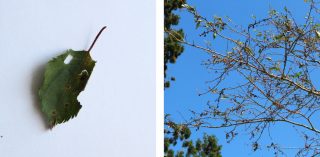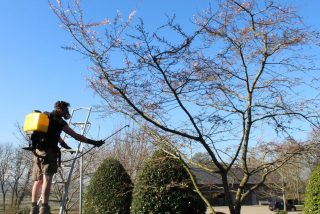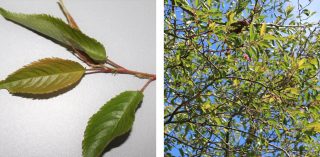Treatment of Shot Hole Disease in small-leaved flowering Cherries
As much as we love our ornamental cherries, they sometimes give us cause for sorrow and concern: Small-leaved cherries, especially the winter-flowering Prunus subhirtella autumnalis, are prone to a serious fungal disease called Shot hole disease or Coryneum blight.
The disease, which is caused by the pathogen Wilsonomyces carpophilus, initially manifests itself in the shape of small reddish-brown spots with a light green ring around them. As the disease progresses, the spots dry out and the damaged tissue falls away, creating holes in the leaves.
Severely infected leaves desiccate and eventually fall. The decreased leaf surface affects the tree’s ability to produce sugars through photosynthesis which weakens the plant eventually to such an extent that it cannot produce flowers.
The pathogen overwinters in infected buds and tree cankers. In spring, spores are dispersed which cause infection as temperature and moisture levels rise. Overhead watering facilitates the infection. As the disease spreads through the tree during the spring, leaf damage occurs and, in an extreme case, may result in a complete defoliation of the tree in the early summer.

“Big guns” are needed to control the disease: We use a systemic fungicide, which is applied fortnightly in February and March, when the new leaves appear. In August, the tree is sprayed with fixed copper or Bordeaux mixture, which does not cure the infection, but acts as a preventative measure.

We first noticed the infection in our Autumnalis cherries in 2014. Five years later, the health of the trees has much improved and they have rewarded us with lots of bloom from November to April this year!

Shot hole disease may affect a wide range of stone fruit. Treatment in edible plants is more problematic because of the potential harmful effects of the chemical agents involved.
